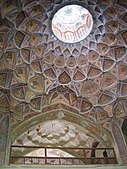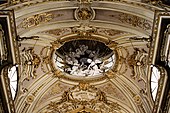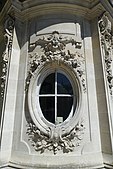Oculus (architecture)

An oculus (from
History
Classical
The oculus was used by the Ancient Romans, one of the finest examples being that in the dome of the Pantheon. Open to the weather, it allows rain and air to enter and fall to the floor, where it is carried away through drains. Though the opening looks small, it actually has a diameter of 8.7 m (29 feet), allowing it to light the building.
Byzantine
The oculus was widely used in the architecture of the
stringcourse on both lateral facades.[3]
Renaissance
Early examples of the oculus in Renaissance architecture can be seen in Florence Cathedral, in the nave clerestory and topping the crowns of the arcade arches.[4]
Neoclassical
Since the revival of dome construction beginning in the
Neo-Palladian architects including Colen Campbell, one can be seen in the dome of Thomas Jefferson's Rotunda at the University of Virginia.[2][5]
Examples
Short visual history of oculli
-
ThePantheon, Rome, Italy
-
Rococo oculus in the Parc de Bagatelle (Paris)
-
Versailles, France), with a festoon-derived ornament at the top
-
Hannover, Germany
-
19th century Eclectic Classicist oculus of the Opéra-Théâtre de Clermont-Ferrand, Clermont-Ferrand, France
-
Beaux-Arts dormer oculus of the Building of Préfecture de Police de Paris, Île de la Cité
-
Art Nouveau oculus of the Hôtel Élysée Palace, Paris
References
- ISBN 978-2-7572-0177-0.
- ^ a b "Oculus window". Royal Institute of British Architects. March 27, 2014. Archived from the original on March 27, 2014. Retrieved 24 January 2014.
- ISBN 978-1-4094-2740-7. Retrieved 24 January 2013.
- ^ "The Cathedral of Santa Maria del Fiore, Florence". muohio.edu. March 27, 2014. Archived from the original on March 27, 2014. Retrieved 24 January 2013.
- ^ "Daylighting in two centroidal spaces at the University of Virginia: Case Study, The Rotunda and Caplin Pavilion". The University of Virginia. Retrieved 24 January 2013.
External links
![]() The dictionary definition of oculus (architecture) at Wiktionary
The dictionary definition of oculus (architecture) at Wiktionary



![Romanesque oculus of the Église Sainte-Anne de Gassicourt [fr], Mantes-la-Jolie, France](http://upload.wikimedia.org/wikipedia/commons/thumb/0/04/Gassicourt_Sainte-Anne_327.JPG/170px-Gassicourt_Sainte-Anne_327.JPG)






![19th century Eclectic Classicist oculus of the Opéra-Théâtre de Clermont-Ferrand [fr], Clermont-Ferrand, France](http://upload.wikimedia.org/wikipedia/commons/thumb/c/c0/Op%C3%A9ra_municipal_de_Clermont-Ferrand%2C_%C5%93il_de_b%C5%93uf.jpg/170px-Op%C3%A9ra_municipal_de_Clermont-Ferrand%2C_%C5%93il_de_b%C5%93uf.jpg)

![Art Nouveau oculus of the Hôtel Élysée Palace [fr], Paris](http://upload.wikimedia.org/wikipedia/commons/thumb/7/76/Louis_Baralis_HSBC_1.jpg/127px-Louis_Baralis_HSBC_1.jpg)
